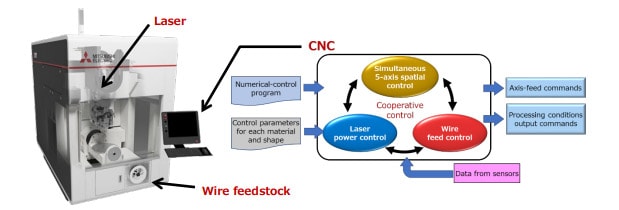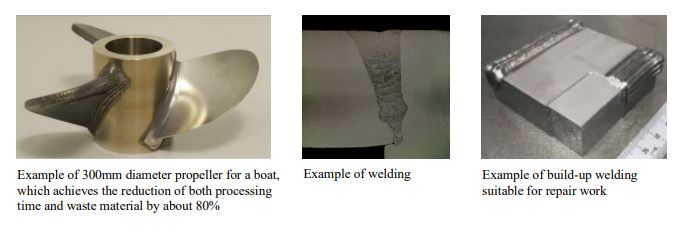Mitsubishi Electric Corporation (TOKYO: 6503) announced today that on
March 1 it will release two models of the “AZ600” wire-laser metal 3D printer, which melts welding wire with
a laser beam to create high-quality 3D structures.
More about the News
Digital additive-manufacturing technology combined with
simultaneous 5-axis spatial control and coordinated control of machining conditions, a world’s first*, delivers
stable, high-quality 3D printing. Furthermore, it contributes to manufacturing in a decarbonized era by
reducing energy consumption, saves resources by shortening of processing time and using highly efficient
production methods such as ‘near-net-shape’, and supports the build-up of repairs for the maintenance of
specialist parts for automobiles, ships and aircraft. Additionally, a new contract printing service utilizing these
printers will help the adoption of additive manufacturing by offering product design consultation, prototyping
and general advice about the application of 3D metal printing.
In recent years, the growing need to reduce CO2 emissions in the metalworking manufacturing industry has
stimulated an increase in demand for more efficient metalworking methods that reduce energy consumption
and conserve finite natural resources. In particular, demand is expected to grow for metal 3D printers, which
create objects from 3D shape data. This has the advantages of significantly shortening the conventional
manufacturing process, reducing waste materials in the manufacturing process, and improving design
flexibility by making it easier to integrate multiple parts and reduce weight. On the other hand, metal 3D
printers that use powder-based feedstock have issues with material management, workability and safety, and
a new additive manufacturing process has been required.
To solve the problems with powder-based printers, Mitsubishi Electric is now launching the AZ600, a world’s
first* wire-laser metal 3D printer that combines simultaneous 5-axis spatial control and digital additivemanufacturing technology that precisely and cooperatively controls processing conditions. This product
realizes high-quality, high-precision 3D printing and contributes to manufacturing that considers its
environmental impact by reducing energy consumption and waste.
The “AZ600” will be exhibited at the “Additive Manufacturing Expo” from March 16-18 at Tokyo Big Sight.
* As of February 24, 2022, according to Mitsubishi Electric’s research
Product Features
1) Unprecedented digital 3D printing technology for stable, high-quality additive manufacturing
Conventional metal 3D printers use either powder or wire feedstocks. Powder feedstock is suitable for complex,
high-precision builds, but incurs problems with material storage, environmental impact and material costs.
Wire feedstock typically uses an arc discharge as its heat source, which entails problems with accuracy due to
high thermal strain and the impact of heat on material layers.
Mitsubishi Electric’s new wire-feedstock method solves these problems by using a laser beam for highly
precise control of heat input according to the build state, thereby combining molding accuracy with the
advantages of wire feedstock. The unique use of computerized numerical controller (CNC), for the cooperative
control of processing conditions such as wire feeding, laser power and axis feed, now makes it possible for
additive manufacturing of high-precision and high-quality three-dimensional structures.
By optimizing the control of axis command values, wire feed amount and laser-power command values based
on sensor data of the build state, a highly stable build process is realized for high-quality 3D printing.

In addition, applying digital printing technology to control the laser beam intensity/power and wire feed with
dedicated computer-aided manufacturing (CAM) for print path generation allows build conditions to be
optimized according to specific three-dimensional structures, using dot or continuous forming.
Furthermore, using consistent-quality wire-feedstock materials contribute to high-quality metal forming for
high-density builds with few voids. Complex 3D structures, which are difficult to realize using an arc heat
source, can be formed with high accuracy using Mitsubishi Electric’s unique high-precision heat control
technology. It is also possible to create hollow spheres, which are, in principle, impossible to be created by
traditional cutting techniques.

2) Simultaneous 5-axis spatial control and new processing technology for speed, resource and labor savings
The near-net-shape method, in which a near-finished shape is formed in a short time and then finished by
cutting, can shorten machining time and reduce waste materials compared to conventional methods which use
cutting for all processes from roughing to finishing. In the test production of a marine propeller with a 300mm
diameter, the near-net-shape method reduced machining time and waste materials by approximately 80%
compared to conventional methods that require final grinding of the overall object. This method can contribute
to energy and resource savings.
Moreover, additive manufacturing can be used as part of the repair and maintenance of expensive consumable
parts, especially those used in harsh environments such as turbine blades or molds, as it can extend the lifetime
and reduce the running costs associated with those parts.
Furthermore, utilizing advanced simultaneous 5-axis spatial control means highly skilled traditional manual
processes for buildup welding and groove welding, using materials like Tungsten Inert Gas (TIG), can now be
performed by metal 3D printing to improve build quality, shorten build time, and save labor.

Main Specifications
Model : AZ600-F20, AZ600-F40
Process category : Directed energy deposition (DED)
Stroke (X×Y×Z) (mm) : 600×600×600
Maximum workpiece dimensions (mm) : Φ500×500
Maximum load workpiece weight (kg) : 500
Machine weight (kg) : 7000
External Dimensions (W×D×H; mm) : 1600×2900×2500
Numerical controller model : M850
Main features : Height sensor, shield-gas numerical control, monitoring camera
Key options : AC-axis specifications & automatic slide doors (sides and ceiling)
Contribution to Environment
The new wire-laser metal 3D printer lowers the environmental impact of production operations and supports
sustainability by extending production equipment life and avoiding production waste.
Subscribe to AM Chronicle Newsletter to stay connected: https://bit.ly/3fBZ1mP
Follow us on LinkedIn: https://bit.ly/3IjhrFq
Visit for more interesting content on additive manufacturing: https://amchronicle.com/




